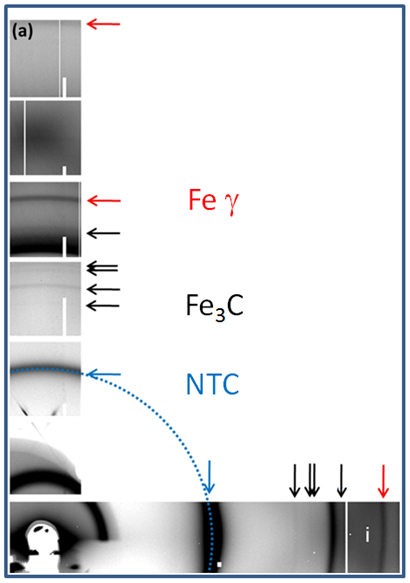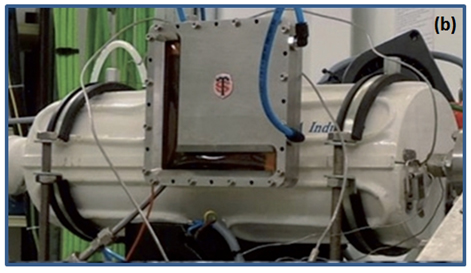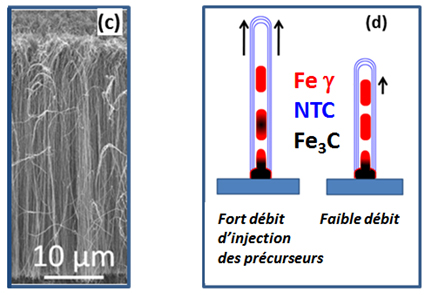During their synthesis, carbon nanotubes can adopt a carpet shape organization, nanotubes growing perpendicular to a substrate. Thanks to their mechanical and electrical properties, these carpets are of interest in the field of composite materials, especially for energy storage applications. The understanding of the formation mechanisms of the nanotubes, as well as the mastering of their structural characteristics or organization, raises interest for a wide community of chemists and physicists, in fundamental research as well as in the industry. Researchers from the Laboratoire Édifices Nanométriques have conceived and developed an original project supported by The French National Research Agency: in-situ time resolved X-ray diffraction study of nanotubes growth.
Experiments were performed on the CRISTAL beamline, inside a prototypical reactor specially designed for the study, which allows one to study the germination and growth of the nanotubes in conditions close to the ones used at a larger scale. Nanotubes growth is realized in a single step by CCVD (Catalytic Chemical Vapor Deposition), thanks to a toluene and ferrocene-based aerosol continuously and simultaneously supplying the synthesis reactor. Synchrotron radiation is required to access to the signal measure at the beginning of the growth where there is extremely little matter. Scientists measured the diffraction patterns from the very first second of growth of the nanotubes and all along the growing process. A deep analysis of the data allowed them to obtain two new pieces of information. The first one concerns the nature of the catalytic particles located at the basis of the carbon nanotubes, and responsible for their germination and growth: cementite nano-crystals (Fe3C). The second one concerns the nanotubes alignment during their growth, which actually quickly increases with the length of the nanotubes. Moreover, at a given length, a key parameter appears to be the density of nanotubes on the growing substrate, which can be controlled with the injection rate of the toluene/ferrocene precursors.

(a) X-ray scattering pattern obtained in-situ at 850°C.
(b) Photo of the synthesis reactor. The “L” shape of the output window of the oven was conceived to allow the measurement of the carbon nanotubes (CNT) alignment, which reflects in the intensities on the diffraction rings in horizontal and vertical directions on the diffraction pattern.

(c) Post-synthesis scanning electron microscopy observation of aligned nanotubes.
(d) Schematic representation of the nanotubes deduced from the in-situ study: cementite Fe3C nanoparticles are the catalytic nanoparticles at the basis of the nanotubes; iron-based nanoparticles also form inside the nanotubes during their growth (g Fe nanoparticles for low precursor injection rate, and both Fe3C and g-Fe nanoparticles for higher rates).
In the future, the idea is to use the skills developed here, to study in-situ the growth of graphene, this new two-dimensional carbonaceous material. The CVD method can be used to produce graphene on a metallic substrate while using mixtures of gaseous hydrocarbons and hydrogen. Recently, considerable efforts have been realized to optimize the substrate cover and to obtain graphene with good structural quality. This is a major stake, particularly for applications in electronics. A new oven dedicated to the study of in-situ graphene growth was developed (project supported by the Labex NanoSaclay) and experiments will be performed on the DiffAbs beamline. Scientists aim at having a better knowledge of the growth mechanisms of graphene, and at studying how to control the number of graphene layers or their correlations.
